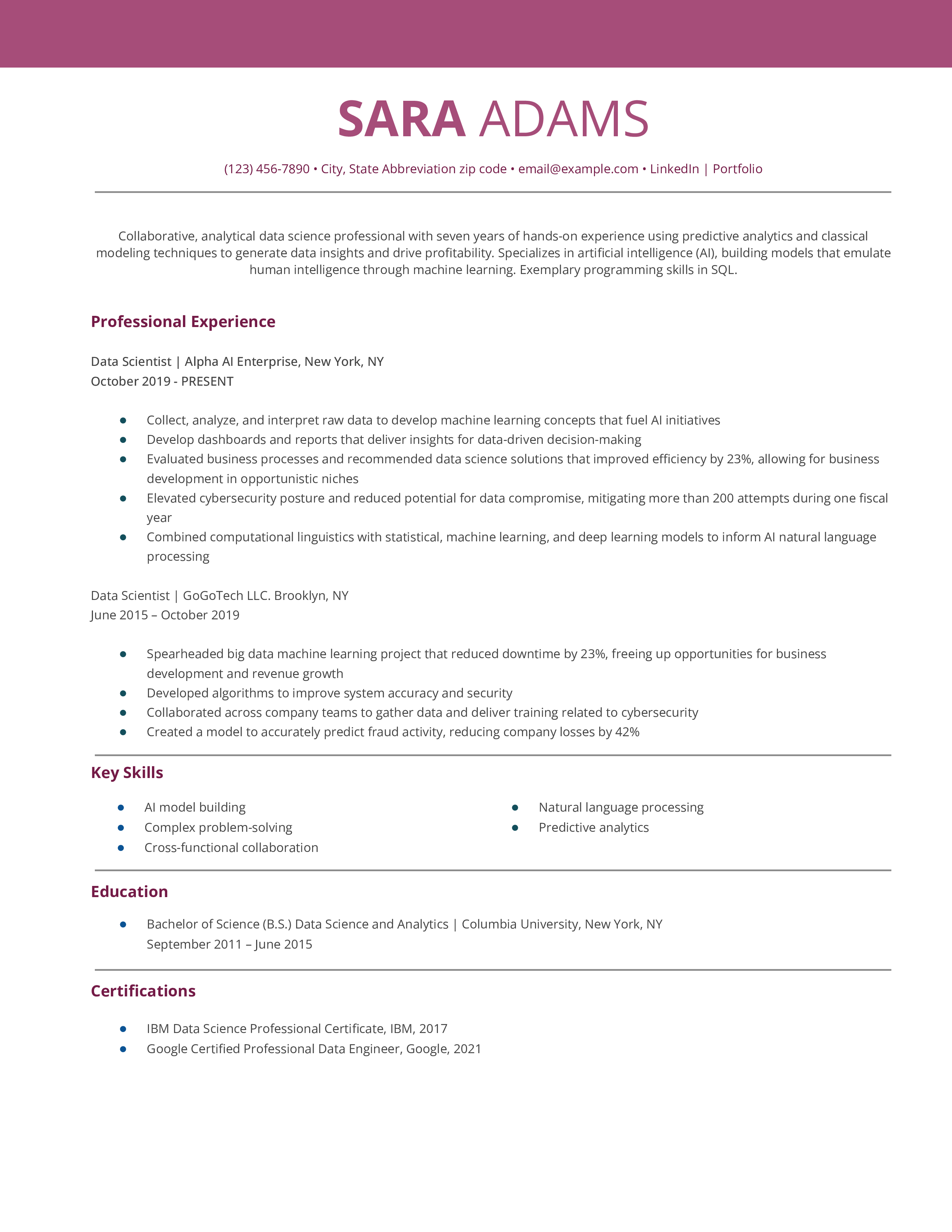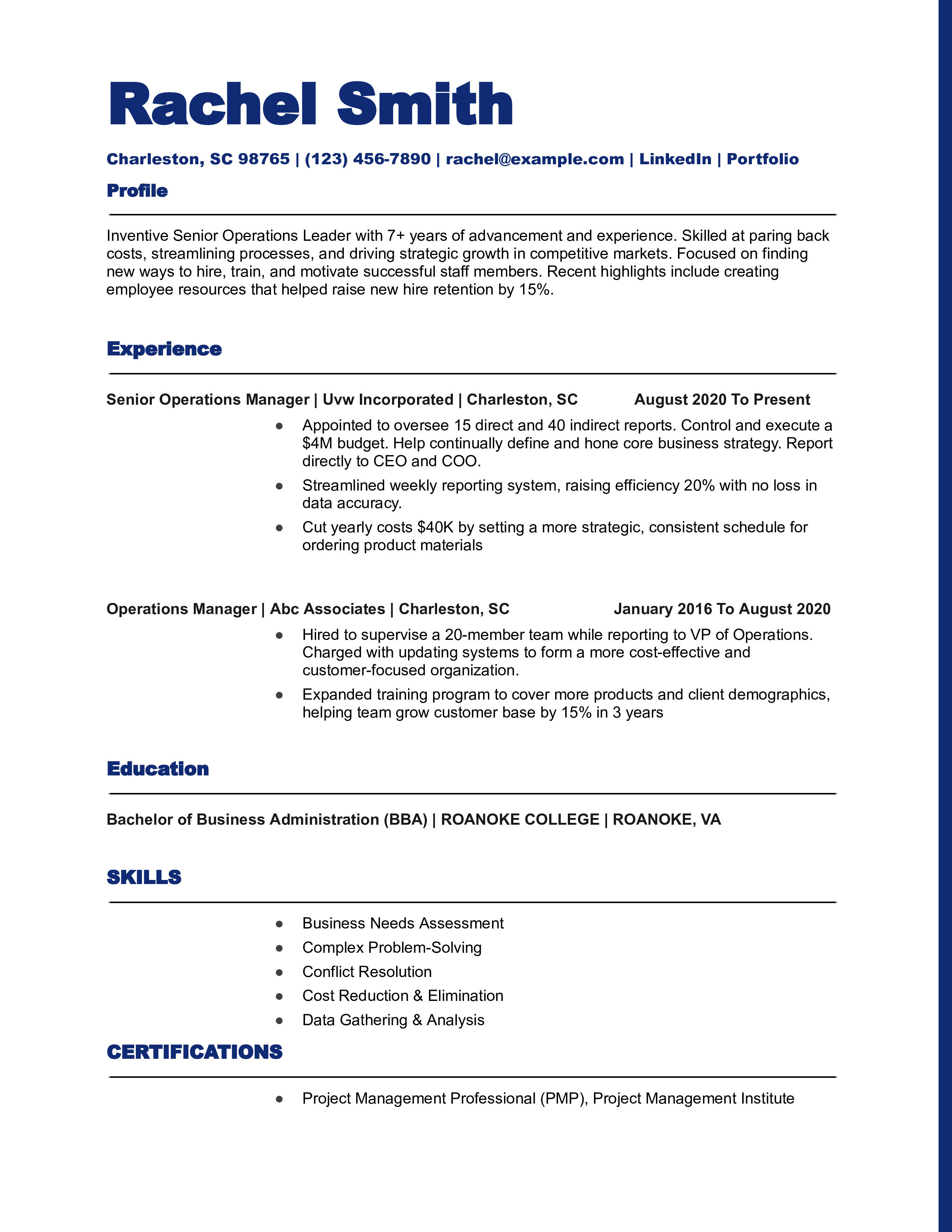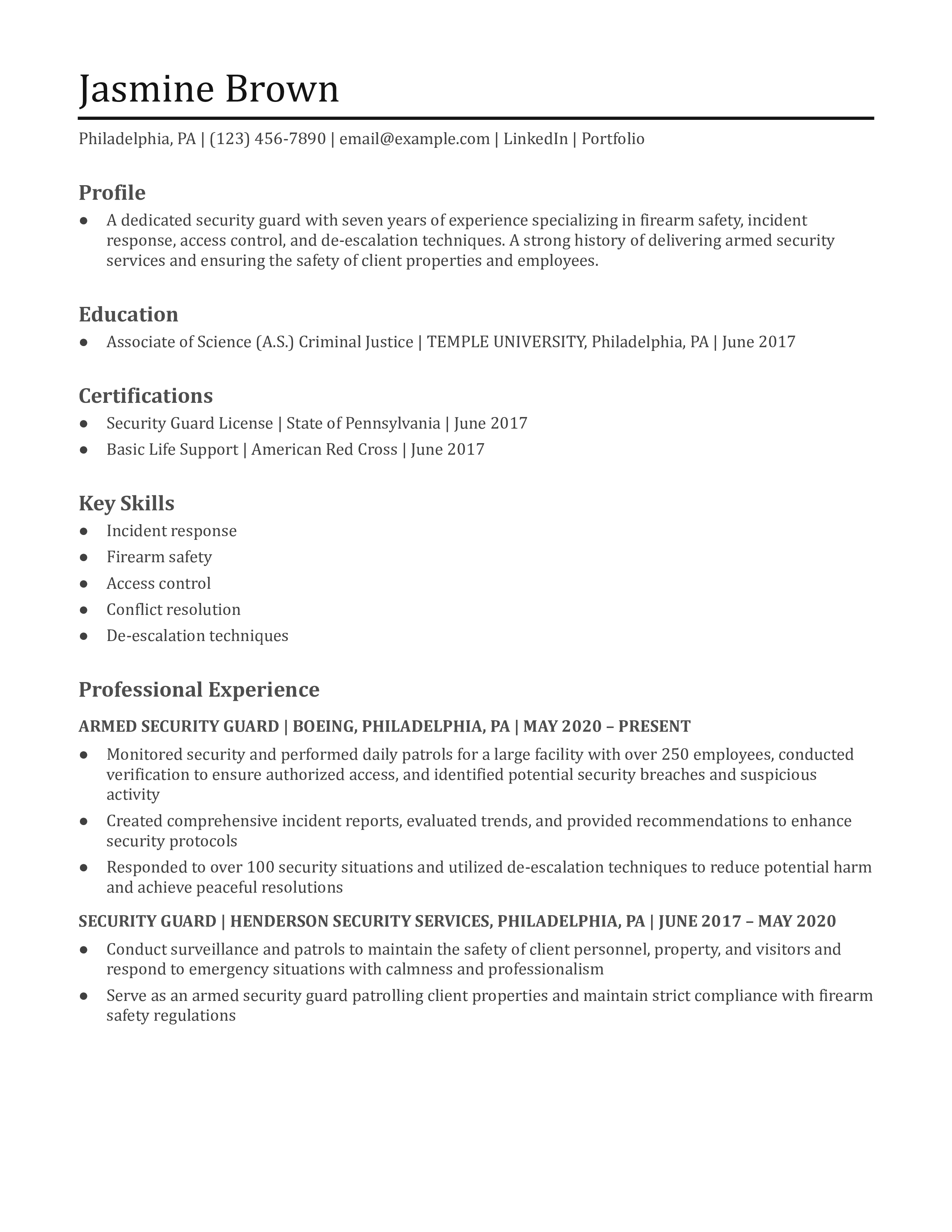For an effective lifeguard resume, focus on your related skills like beach safety education, emergency response, or team collaboration. Give examples of your success as a lifeguard or in similar roles, and show your knowledge base by citing any training or certificate programs you’ve done. This guide provides expert tips to help you create a results-driven resume showing your best lifeguard qualifications.
Key takeaways:
- Brainstorm details about your work history on a separate document or sheet of paper. Then, identify the most relevant ones to feature in your experience section – this helps you focus your resume on the role of lifeguard.
- Use bullet points to accent your achievements. Start each bullet point with a strong verb like “Created,” “Prevented,” or “Enhanced.”
- Follow the combination resume format to provide all required information while positioning yourself for lifeguard jobs that interest you.
Lifeguard Resume Templates and Examples (Download in App)
Lifeguard Resume Example
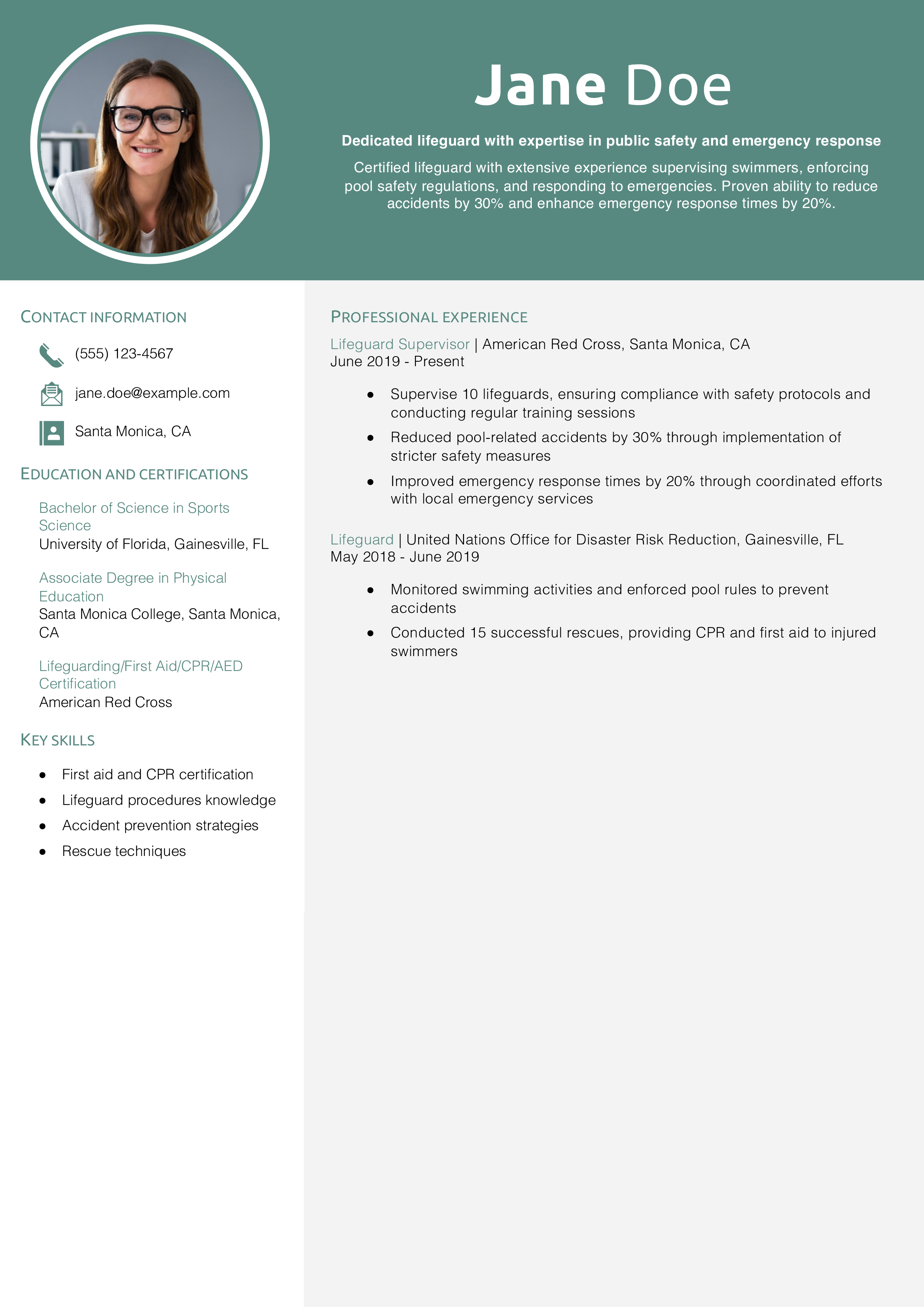
Beach Lifeguard Resume Example
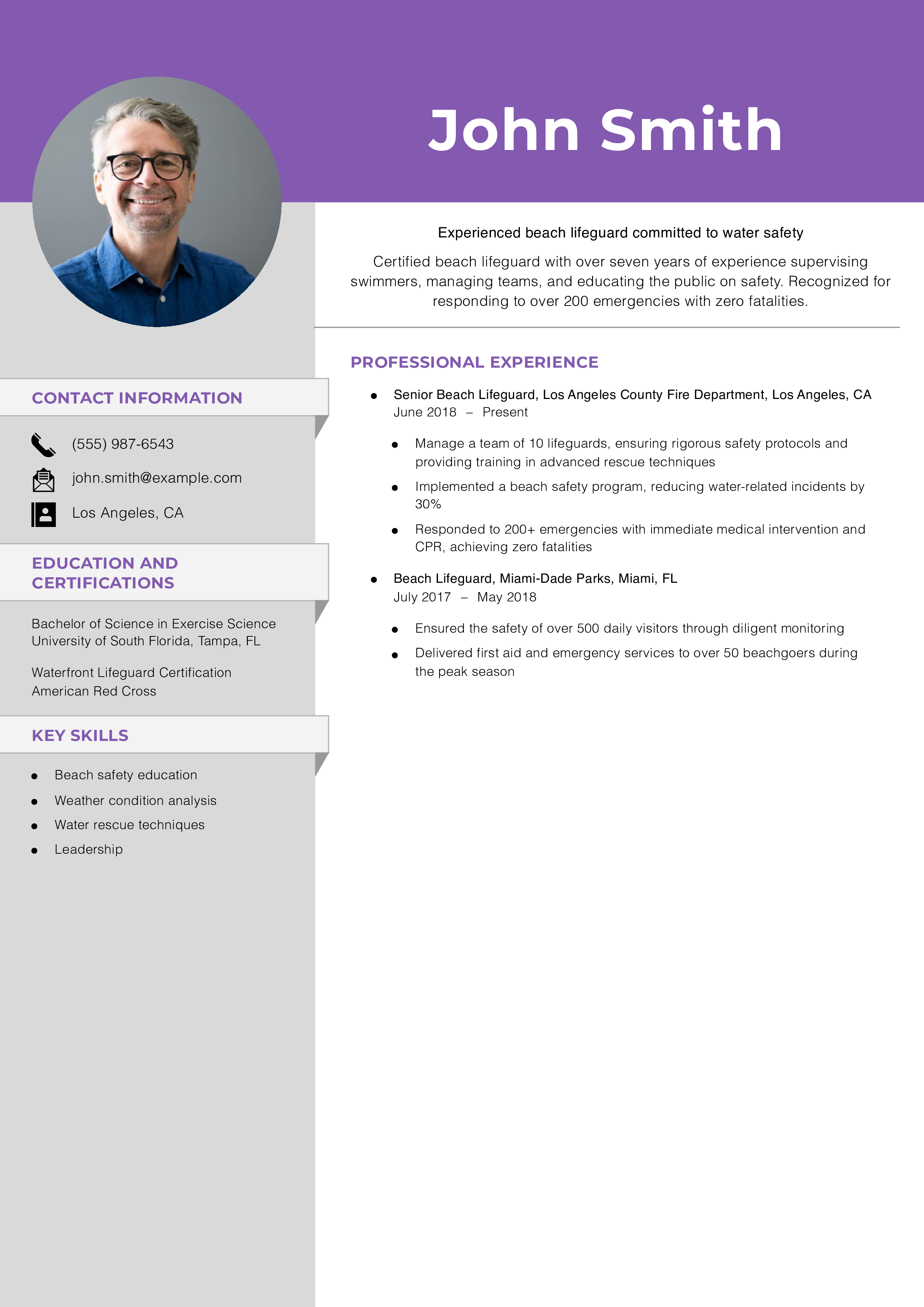
Head Lifeguard Resume Example
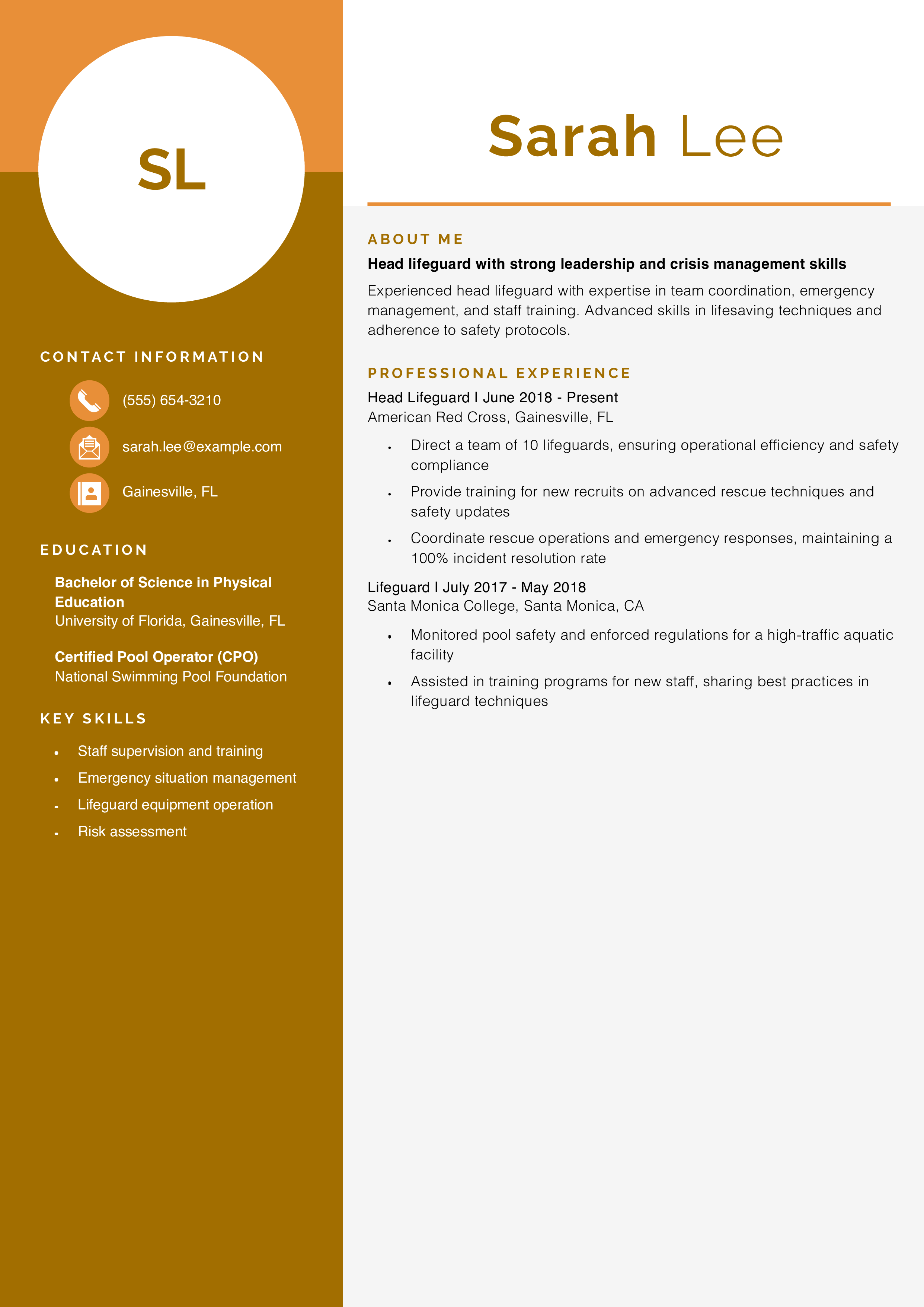
Lifeguard Supervisor Resume Example
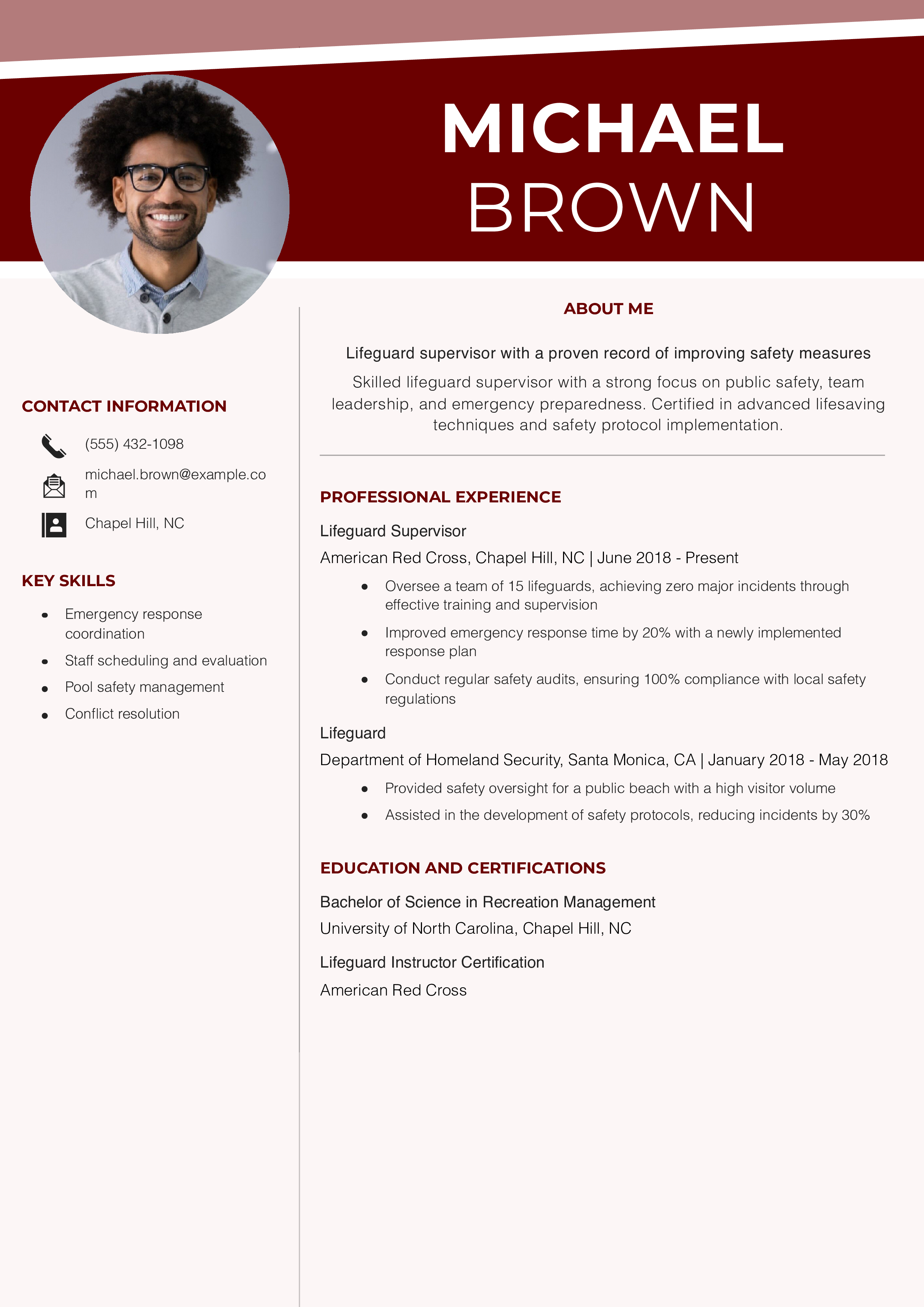
Aquatic Safety Specialist Resume Example
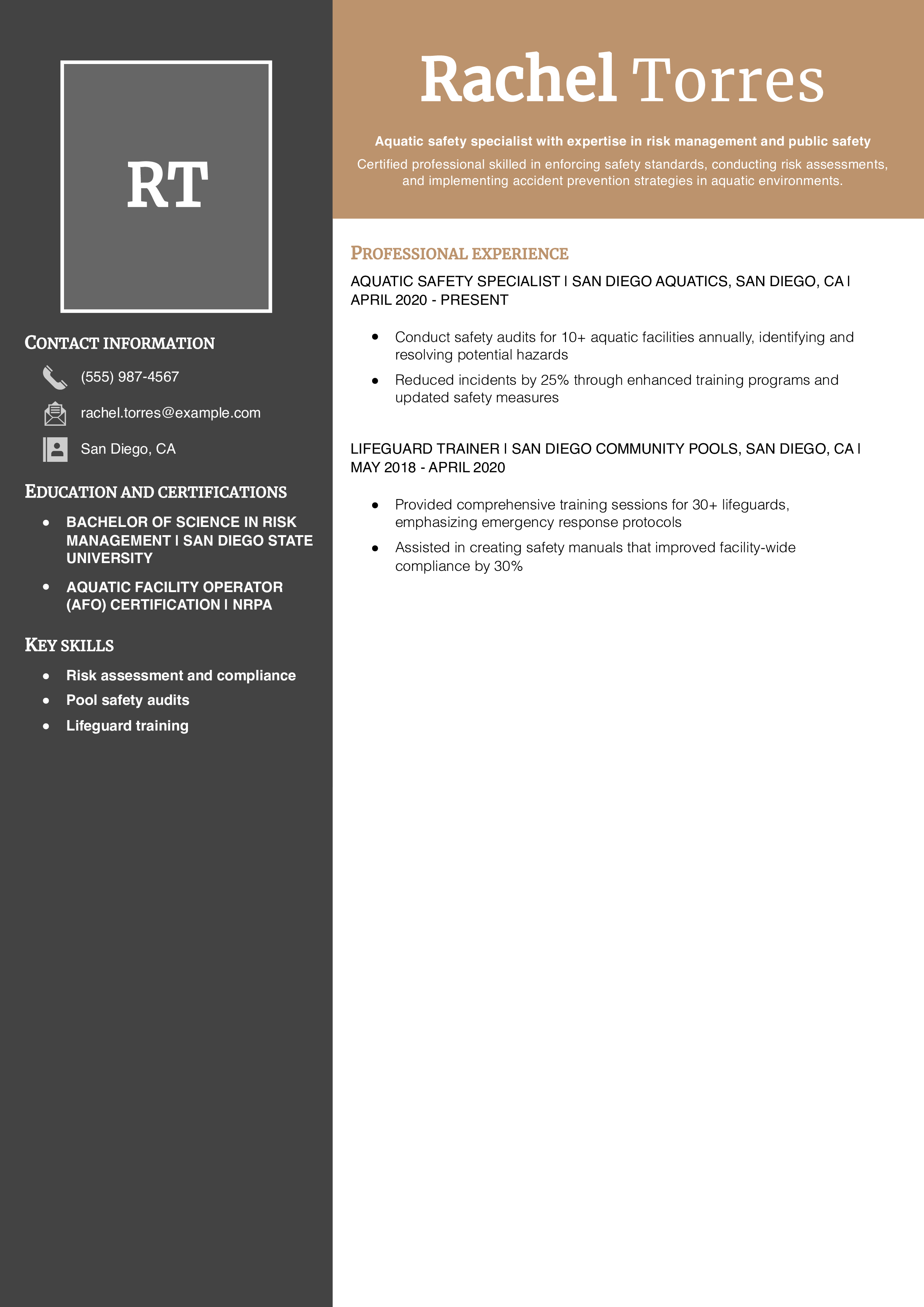
Waterpark Lifeguard Resume Example
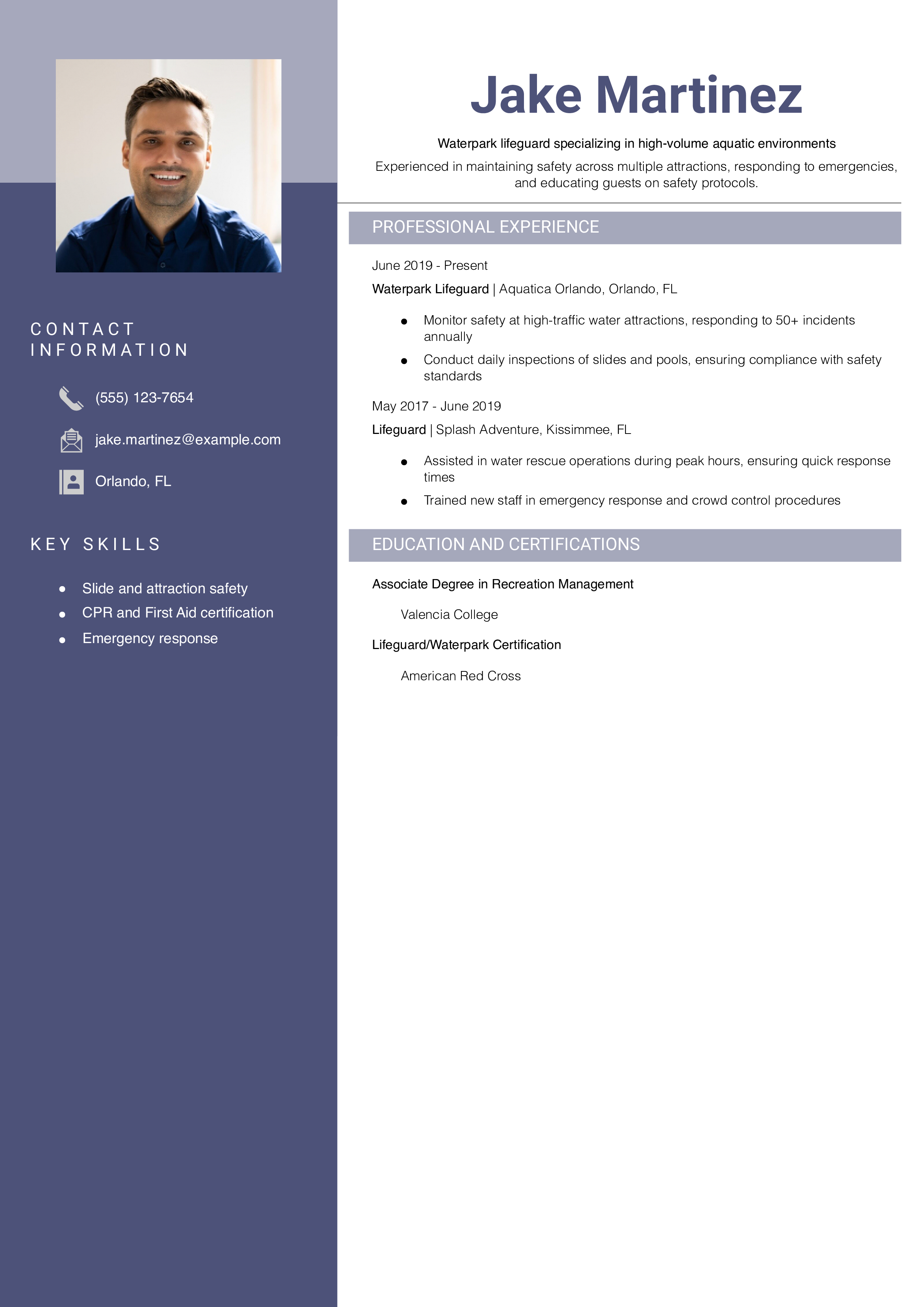
Ocean Rescue Lifeguard Resume Example
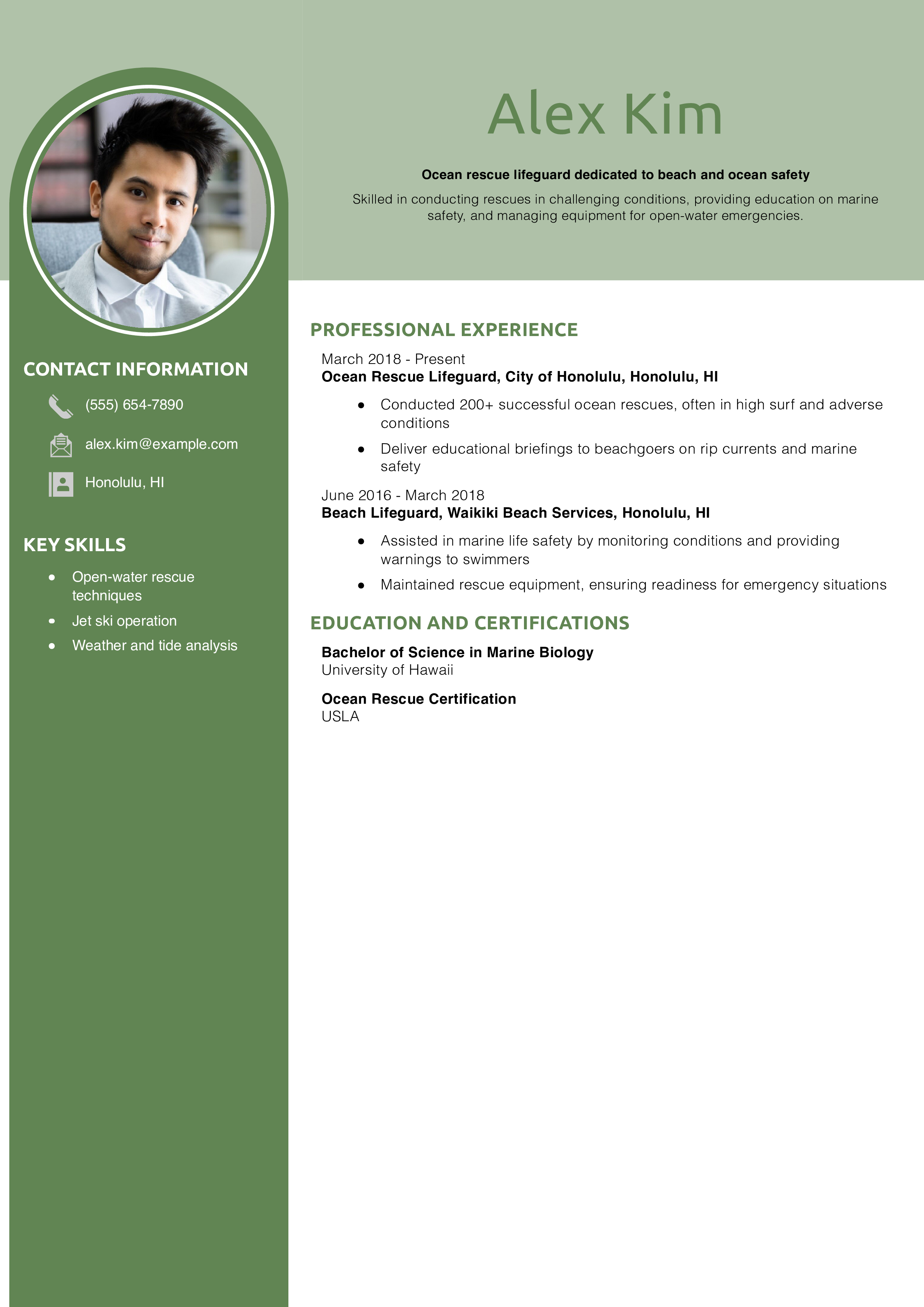
Recreational Lifeguard Resume Example
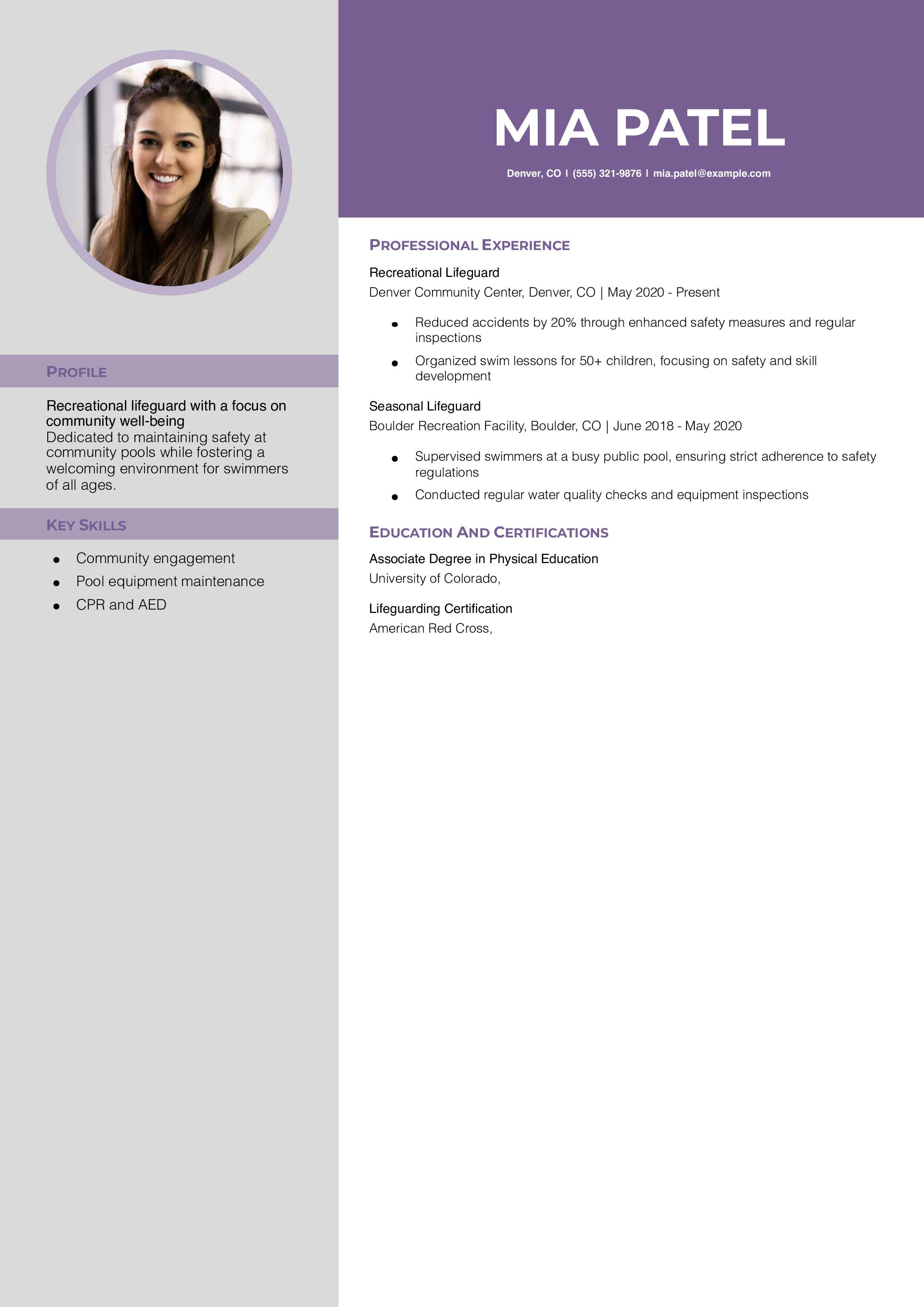
Aquatic Program Coordinator Resume Example
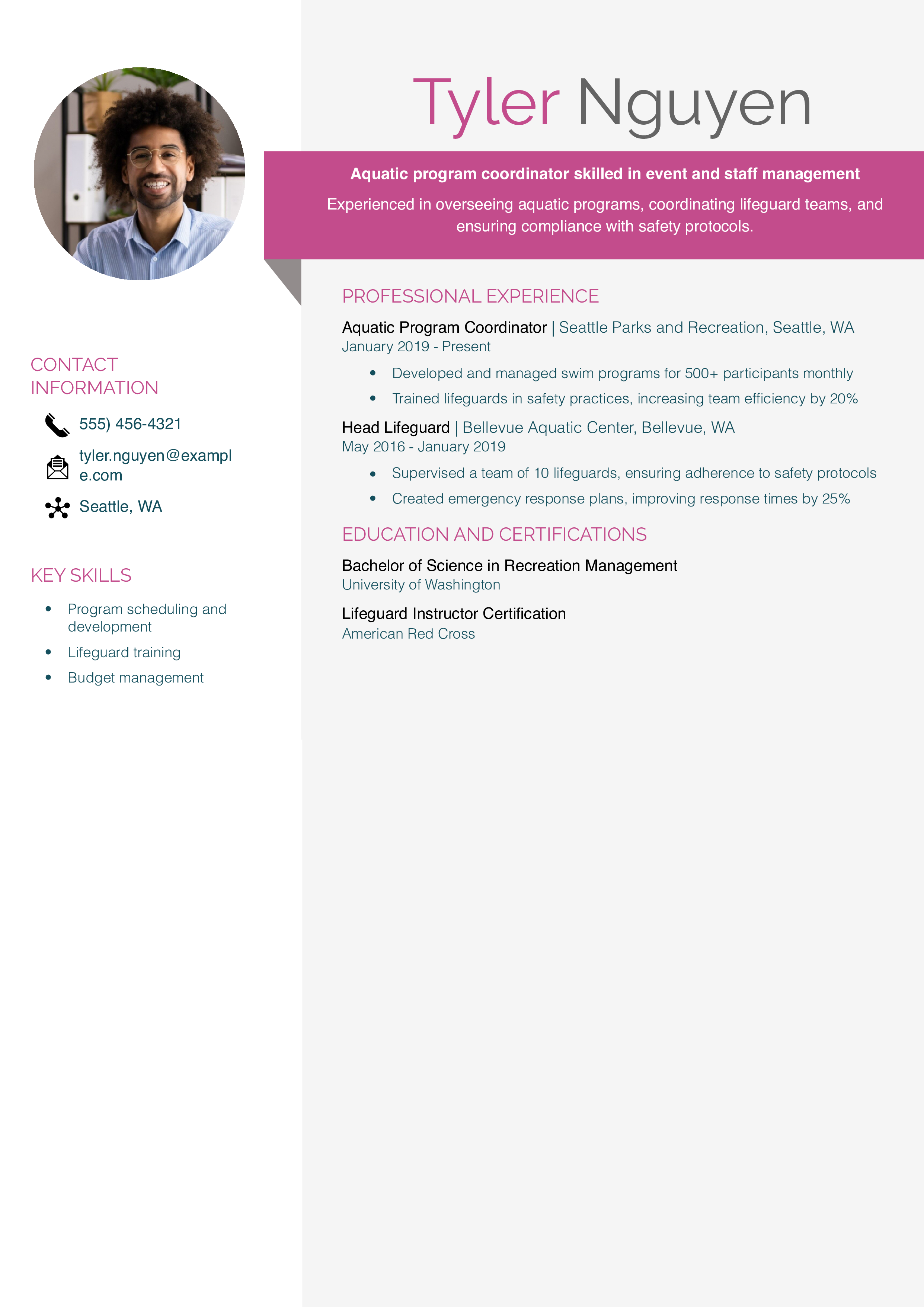
Pool Maintenance Technician Resume Example
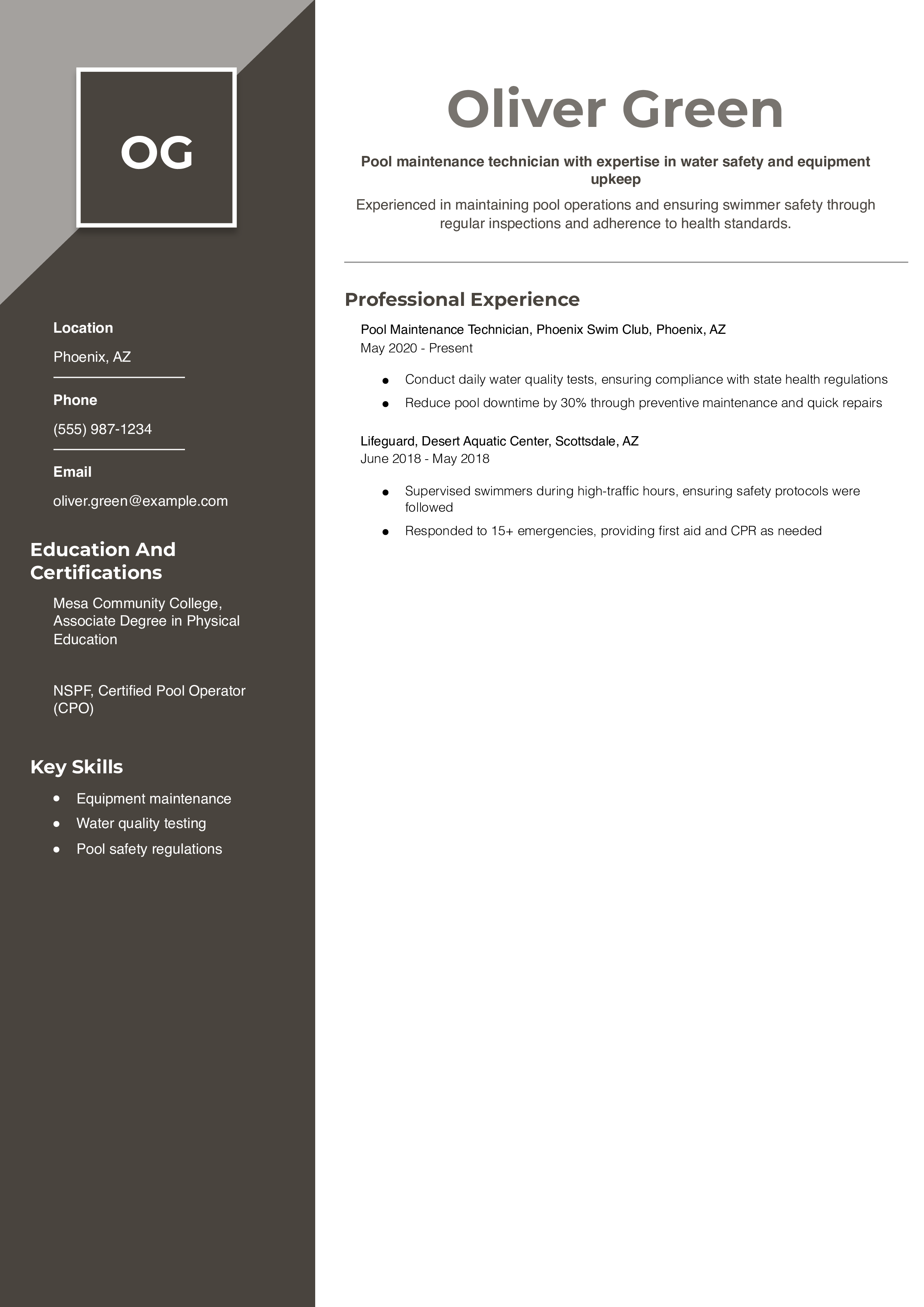
Waterfront Specialist Resume Example
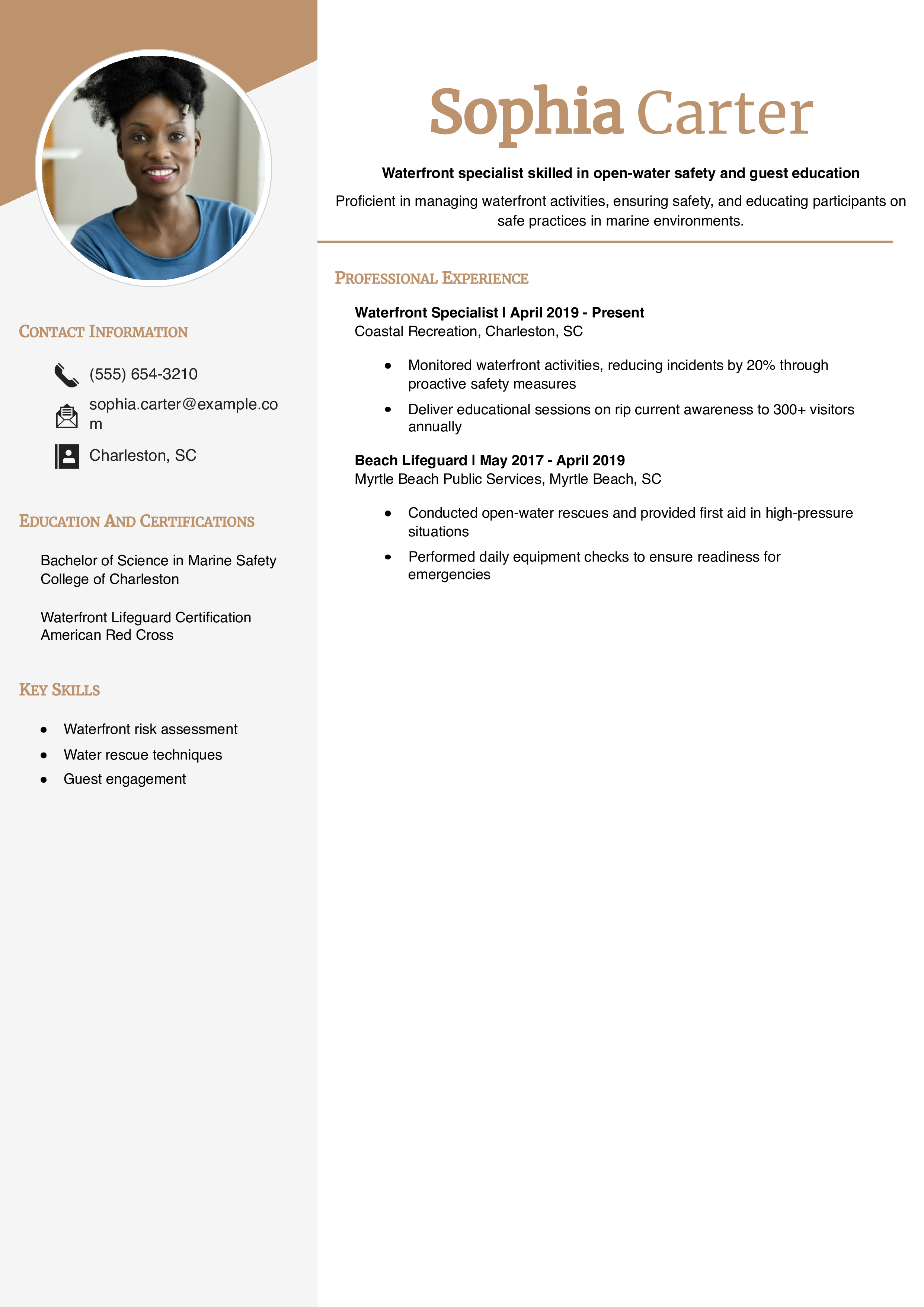
Aquatic Risk Manager Resume Example
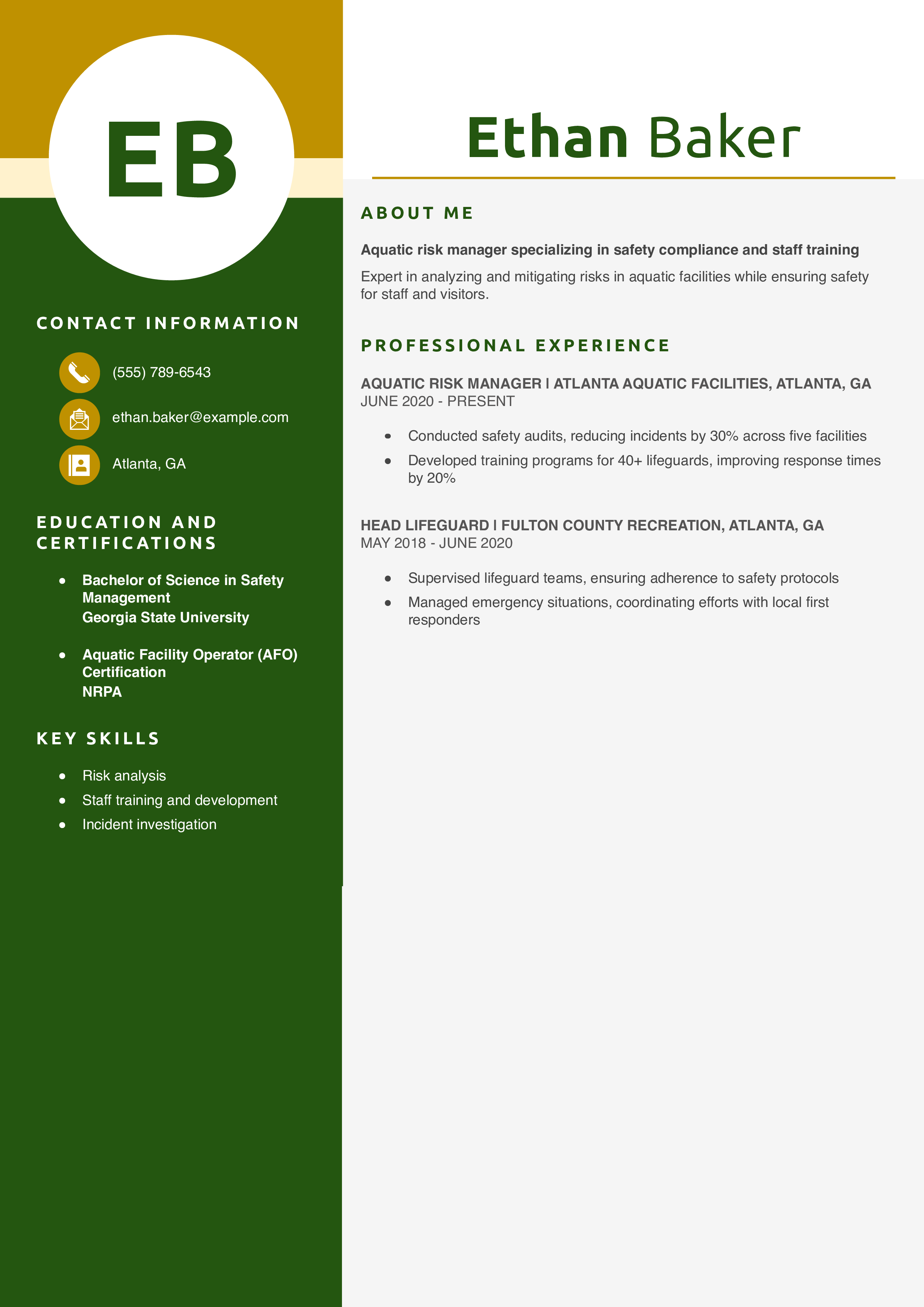
Lifeguard Instructor Resume Example
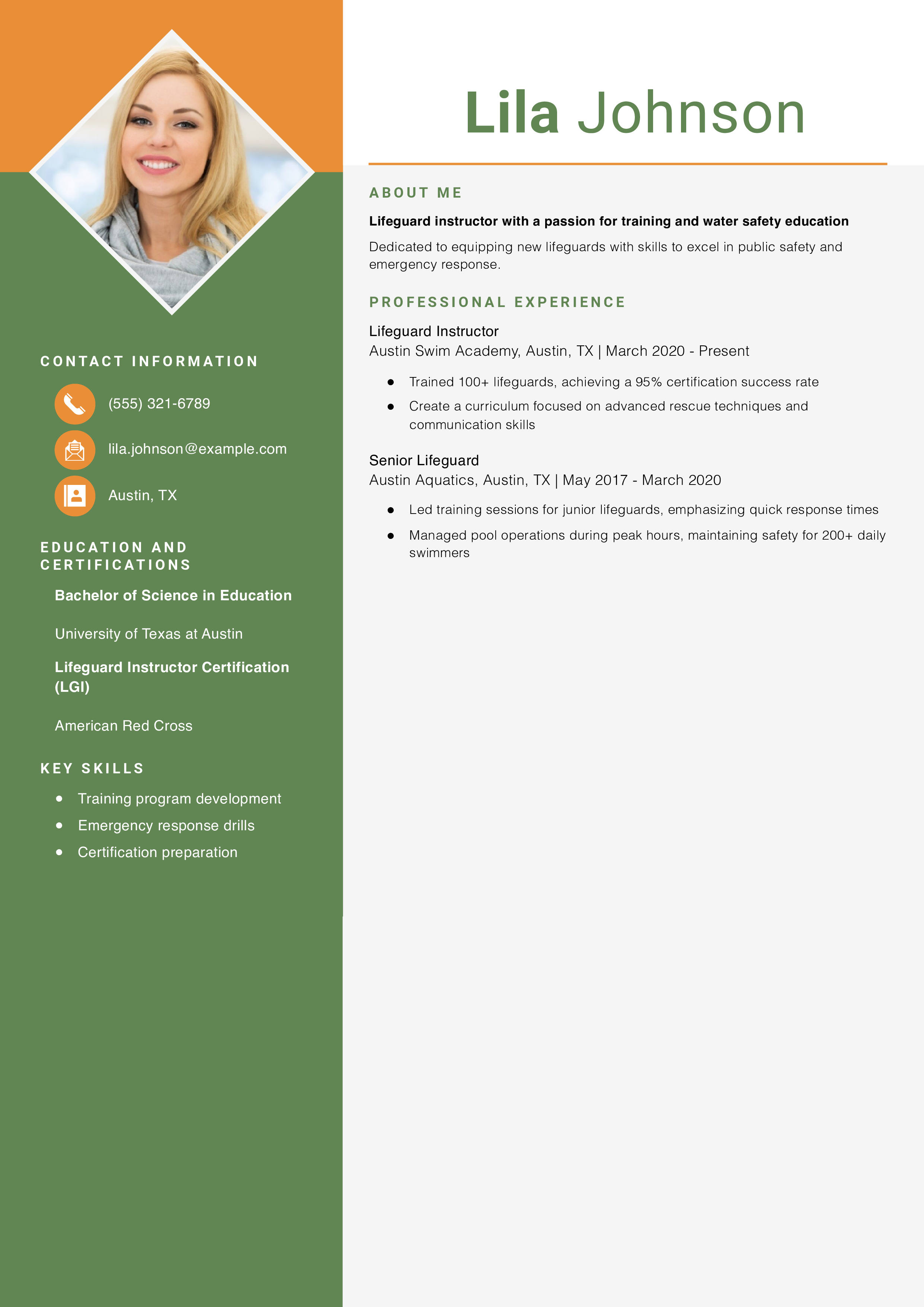
Head Swim Coach Resume Example
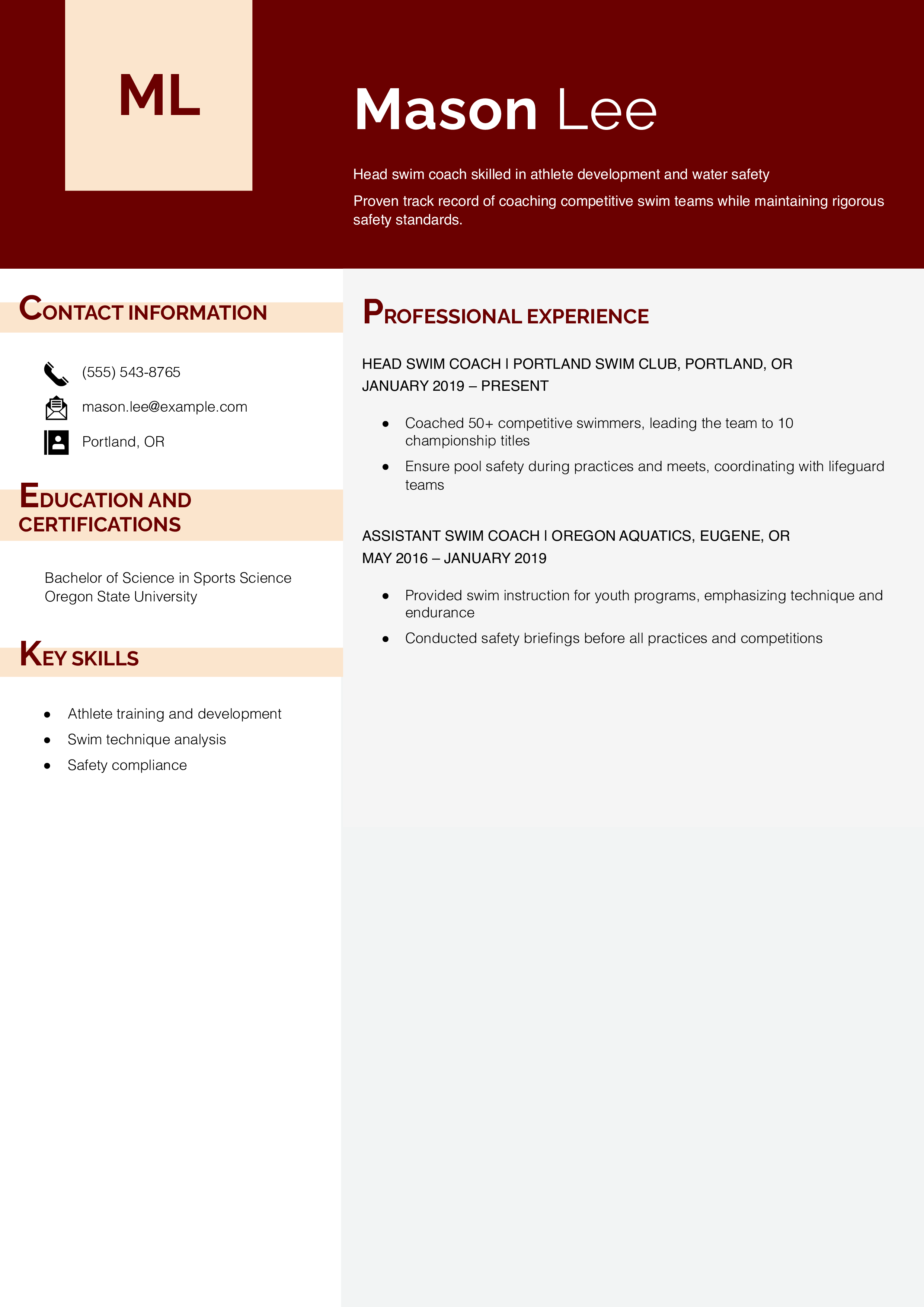
Camp Aquatics Director Resume Example
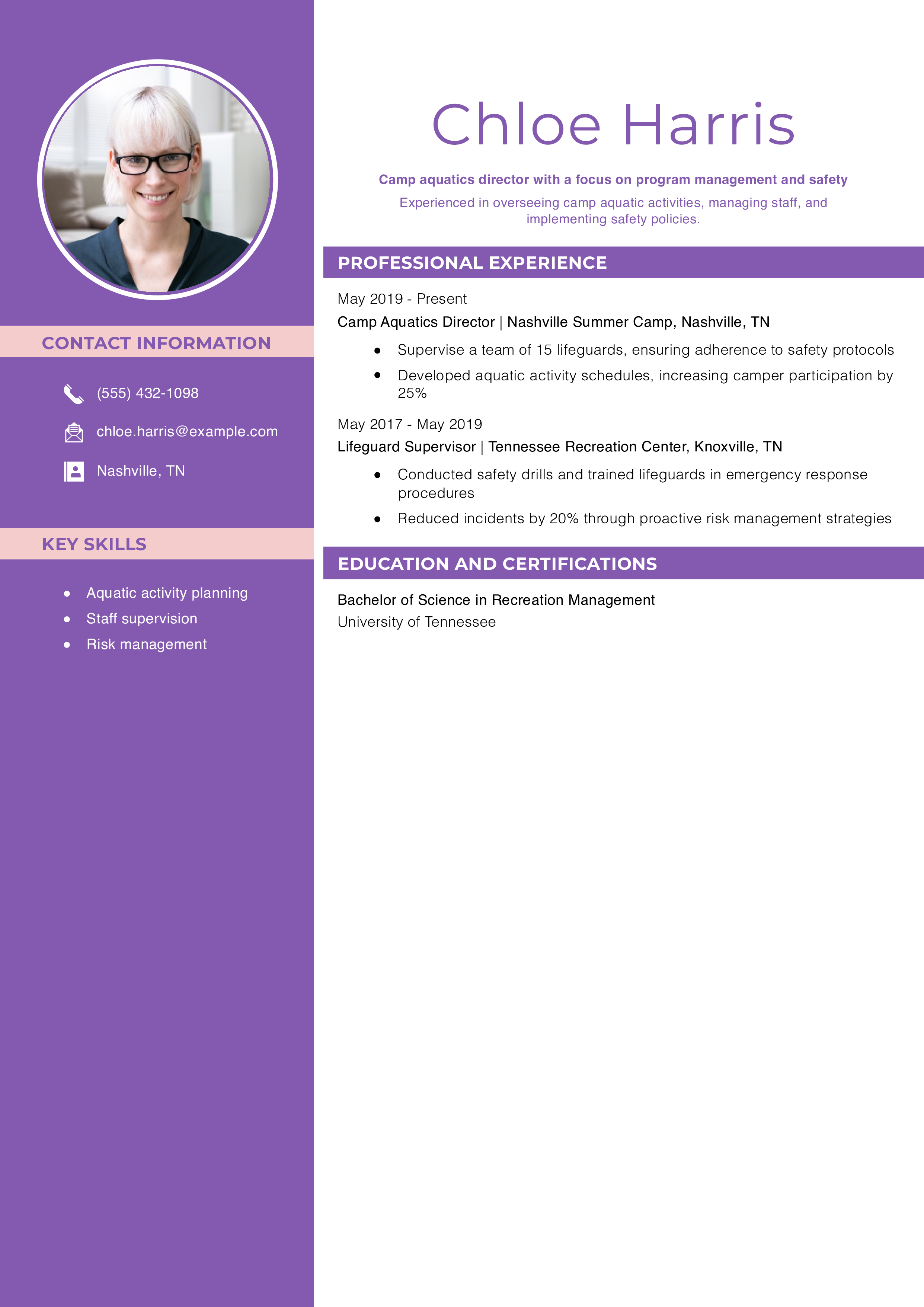
Adaptive Aquatics Specialist Resume Example
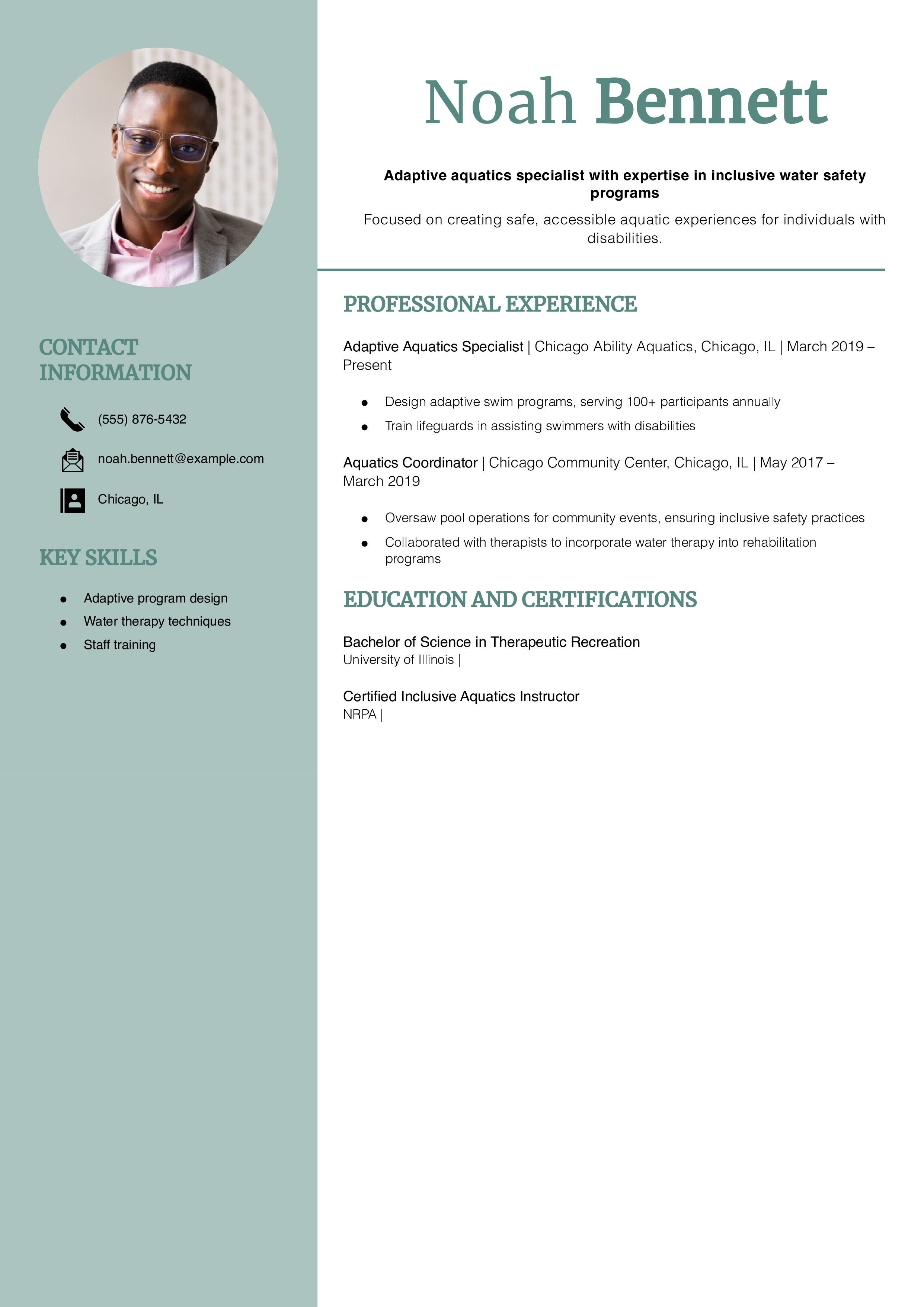
Lifesaving Trainer Resume Example
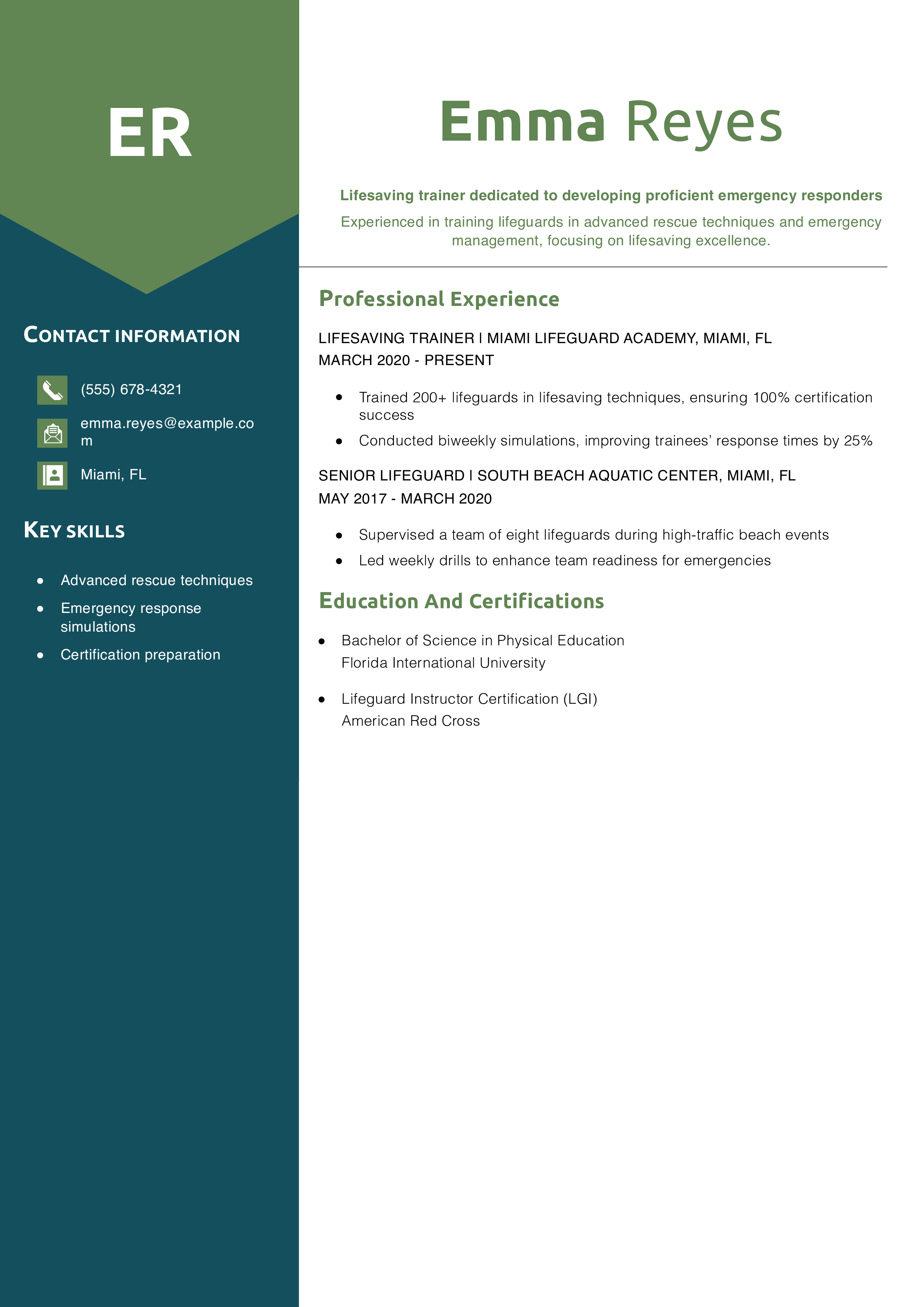
Event Safety Coordinator Resume Example
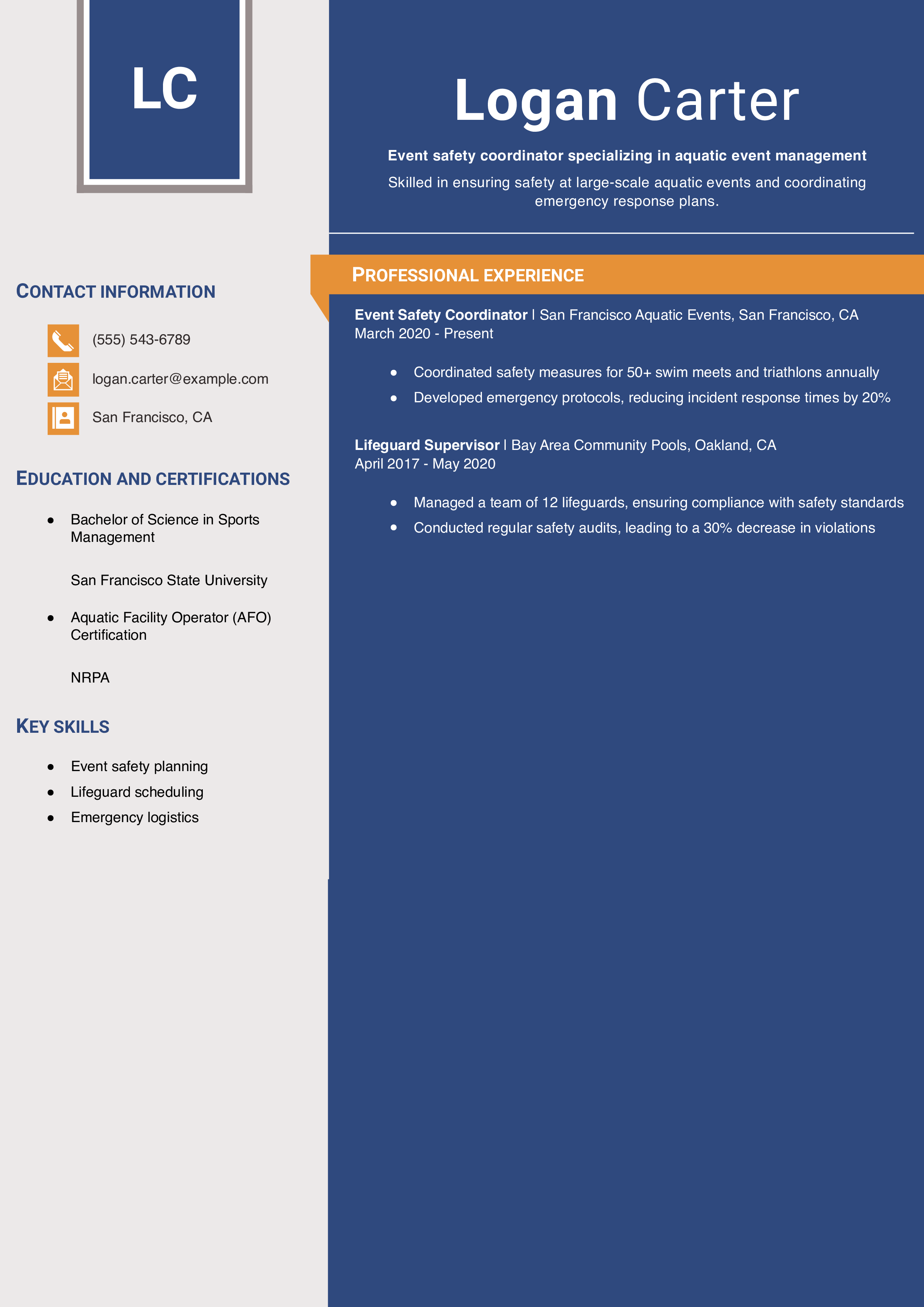
Aquatic Health and Safety Officer Resume Example
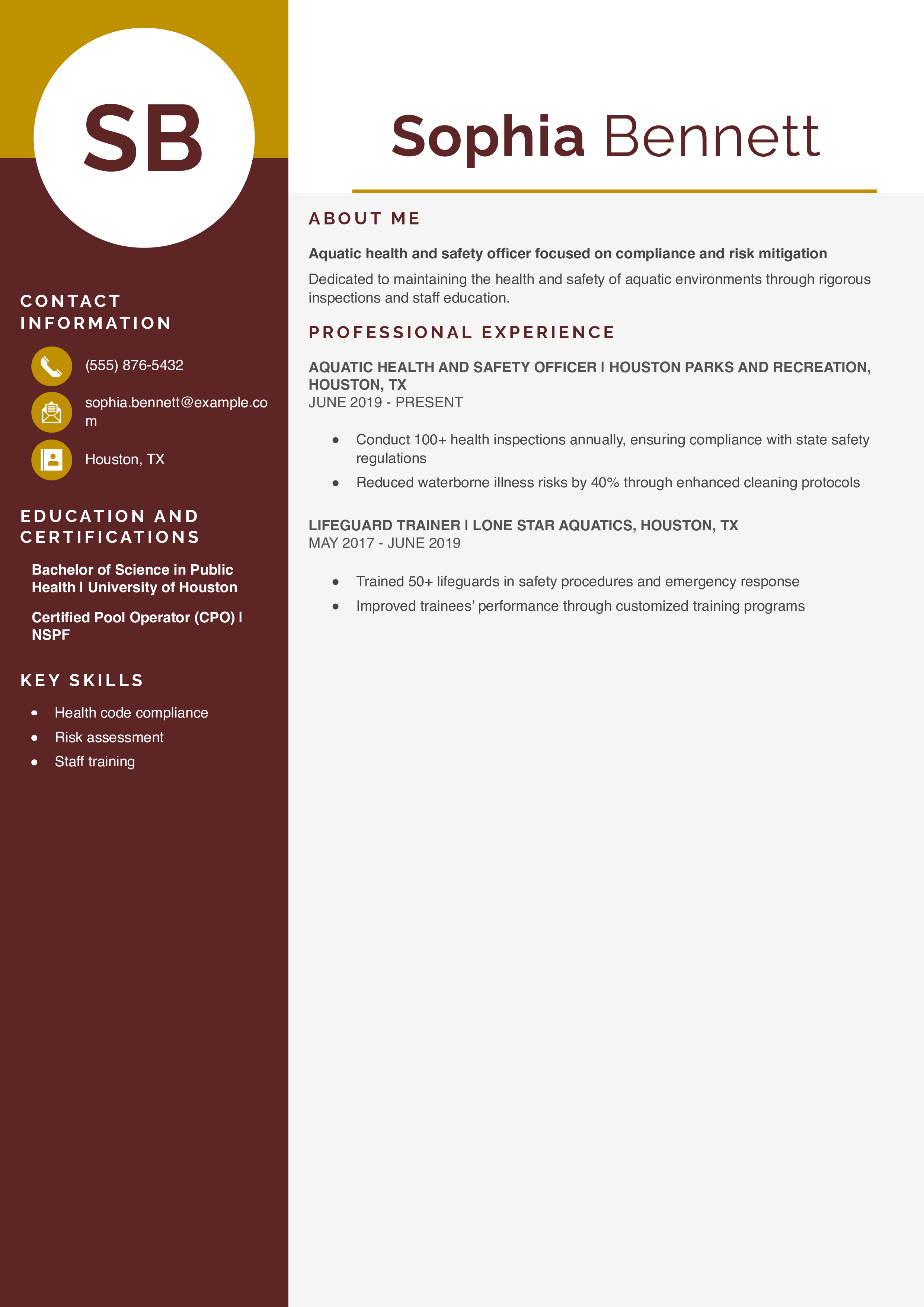
Aquatics Coordinator Resume Example
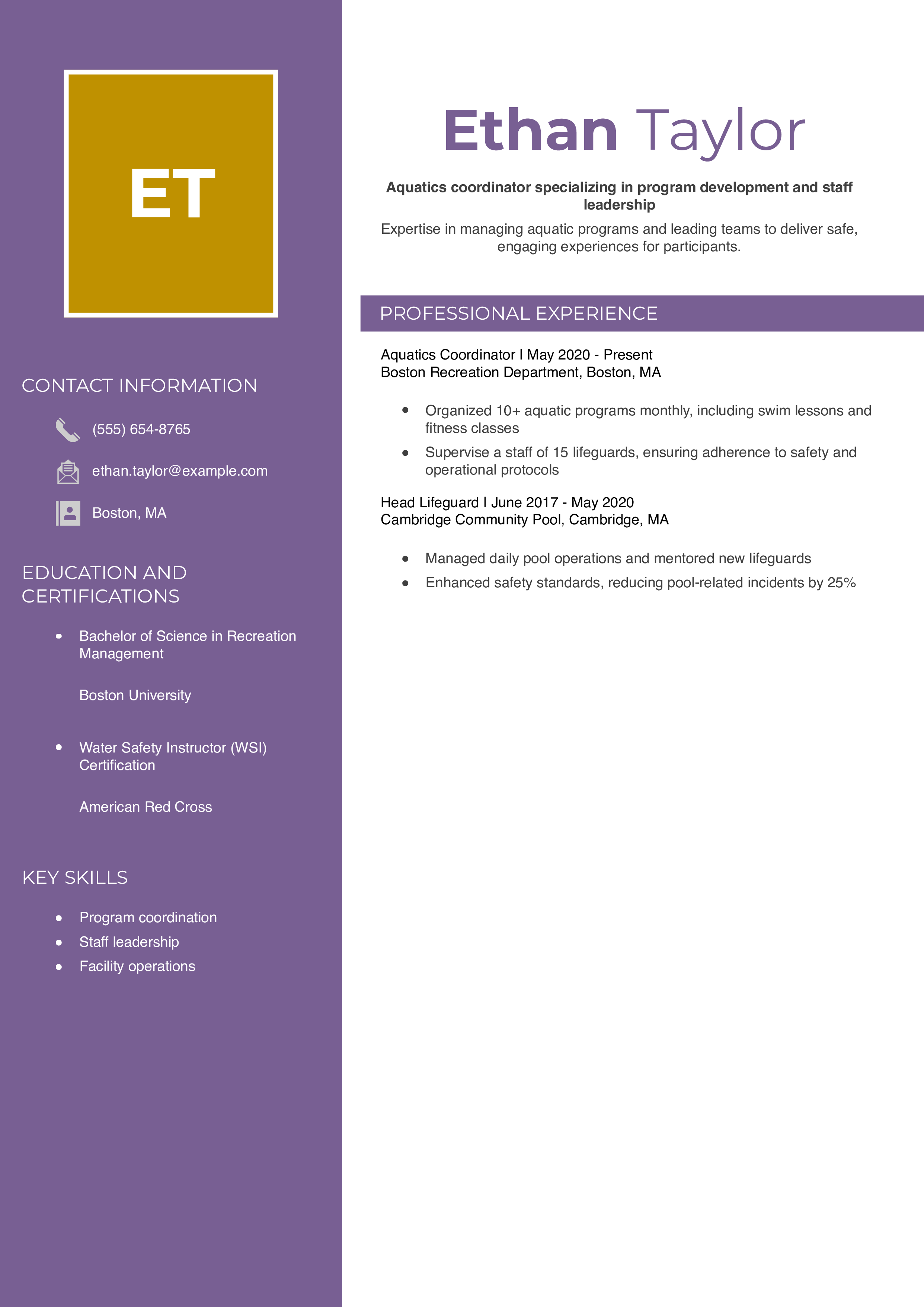
Legal Assistant Text-Only Resume Examples and Templates
How To Write a Lifeguard Resume
Your lifeguard resume should usually include these sections:
- Contact information
- Profile
- Key skills
- Professional experience
- Education and certifications
Below are tips and samples to help you organize each resume section.
1. Share your contact information
This may be the easiest part of your resume, but it’s also the most important. Ensure your contact information is current and accurate so employers can reach you for an interview. Give your full name, phone number, email address, location, and links to any online professional profiles.
Template:
Your Name
(123) 456-7890 | [email protected] | City, State Abbreviation Zip Code | LinkedIn
2. Write a dynamic profile summarizing your qualifications
You can impress hiring managers at the top of your resume by giving the three to five primary reasons you’ll excel as their next lifeguard. These key selling points may include your:
- Years of lifeguard-related work experience
- Work style or approach (reliable, efficient, collaborative…)
- Education degree(s) or certifications in your field
When writing this section, use phrases like “skilled in” or “focused on.” Avoid more elevated terms like “outstanding” or “exceptional,” as these can come off arrogant.
(Note: Most job seekers find it easier to write their profile last.)
Example:
Experienced beach lifeguard committed to water safety
Certified beach lifeguard with over five years of experience supervising swimmers, managing teams, and educating the public on safety. Recognized for responding to over 200 emergencies with zero fatalities.
3. Add a compelling section featuring your lifeguard experience
For each job in your recent work history, brainstorm your (possibly various) duties and achievements on a separate document or sheet of paper. Then, review your notes in light of your target job, and choose the most relevant ones to feature as bullet points in this section. You can create a detailed and focused experience section by filtering your information this way.
Example:
Head Lifeguard, American Red Cross, Gainesville, FL | June 2018 to present
- Direct a team of 10 lifeguards, ensuring operational efficiency and safety compliance
- Train new hires on advanced rescue techniques and safety updates
- Coordinate rescue operations and emergency responses, maintaining a 100% incident resolution rate
Resume writer’s tip: Quantify your experience
When possible, use relevant performance data to measure the results you’ve achieved as a lifeguard. Hard numbers put your work in context and give recruiters a better sense of your scope and impact.
Do
- "Improved emergency response time by 20% with a newly implemented response plan"
Don’t
- "Improved emergency response time with a newly implemented response plan"
Resume writer’s tip: Tailor your resume to each application
For each job posting you respond to, note any details about the swimming facility. How do these areas compare to your recent experience? You can make a stronger first impression on the hiring manager by citing these similarities in your profile.
For instance, say you’re applying to a popular local beach. You could enhance your profile by changing your first line from “Lifeguard with seven years of experience” to “Lifeguard with seven years of experience, including five years at popular beach facilities.”
What if you have no experience as a lifeguard?
As long as the job posting doesn’t strictly require it, you don’t need direct work experience to write an effective resume. The trick is focusing on your transferable skills, which can come from various areas such as your past jobs, internships, volunteer positions, or training courses. By detailing these areas in full on your resume, you can ensure it helps you get interviews for your target job.
4. Include education and certifications relevant to lifeguarding
With the education and certifications sections, you can show you have a strong knowledge base in your field. Each degree or credential also serves as a formal endorsement of your skills and professionalism. Following are templates to help you organize this information on your resume. (Note: Leave out graduation dates if they’d put you at risk of age discrimination.)
Education
Template:
[Degree Name], [School Name], [City, State Abbreviation] | [Graduation Year]
[Relevant honors, coursework, or activities]
Example:
Bachelor of Science in Recreation Management, University of North Carolina, Chapel Hill, NC
Certifications
Template:
[Certification Name], [Awarding Organization] | [Completion Year]
[Description if the credential is lesser-known but relevant]
Example:
Lifeguard Instructor Certification, American Red Cross
5. List lifeguard-related skills and proficiencies
A skills section lets you quickly show how to support a swimming facility. Below, you’ll find some key terms and skills to consider for this section:
| Key Skills and Proficiencies | |
|---|---|
| Accident prevention strategies | Beach safety education |
| Conflict resolution | Customer communications |
| Emergency response | First aid |
| Lifeguard equipment operation | Lifeguard procedures |
| Pool safety management | Risk assessment |
| Staff scheduling and evaluation | Staff supervision and training |
| Team collaboration | Team leadership |
| Water rescue techniques | Weather condition analysis |
| Workplace safety | |
Resume writer’s tip: Use specific action verbs
Start each bullet point with a strong action verb. Dynamic verbs help you keep the hiring manager’s attention and show the varied nature of your experience.
The following list can help you find a good mix of action verbs for your lifeguard resume:
| Action Verbs | |
|---|---|
| Created | Decreased |
| Enforced | Enhanced |
| Ensured | Fostered |
| Generated | Grew |
| Improved | Increased |
| Introduced | Lowered |
| Managed | Monitored |
| Oversaw | Prevented |
| Protected | Ranked |
| Reduced | Reversed |
| Safeguarded | Streamlined |
| Trained | Updated |
| Won | |
How To Pick the Best Lifeguard Resume Template
A resume is a simple tool for professional communication and should be formatted that way. Choose a clear and straightforward template, and avoid any with elaborate graphics or various colors and font styles. Simple resume design helps a hiring manager scan for relevant information. It also helps you tailor the document to each job application and update your work history.
Frequently Asked Questions: Lifeguard Resume Examples and Advice
Focus on editing your skills section. With a few quick changes to this section, you can enhance your resume and help it get past screenings by applicant tracking systems (ATS).
First, look closely at the job posting and highlight any required skills. Then, compare those highlighted terms with your resume’s existing skills section. Delete any skills from your list that don’t appear in the job posting, and add any missing skills of yours that do. Say the job posting calls for experience in training new hires, which you have. Add the phrase “New hire training” to your skills section so ATS and human readers can see you have the leadership ability they want.
The combination (or hybrid) format, because it lets you introduce yourself both clearly and strategically. According to job search experts Wendy Enelow and Louise Kursmark, this format “gives you many opportunities to share your specific successes…. It offers immense flexibility in an easy-to-follow structure.”
A combination resume has these two features:
- An introduction describing your strengths. Usually, the resume intro will be a profile paragraph and skills list, as in the examples on this page. But there are plenty of variations. Depending on your job search, you may omit one or both of these sections in favor of a one- or two-sentence professional headline. Whatever approach you choose, make sure your introduction tells why you’re great for the job.
- One or more experience sections. Hiring managers want to know your latest career activities. The combination format lets you provide that information with sections for your recent years’ work, internship, education, or other experience. For most job seekers, the bulk of their combination resume will be a “Professional Experience” section with detailed job descriptions in reverse chronological order.
Expert advice: include a cover letter with your resume
A good cover letter sharpens your application by telling why you’re interested in this particular job. As with starting your resume, brainstorm your thoughts on a separate document or paper and choose the most compelling ones as your foundation. When possible, quote or paraphrase text from the job posting and explain how it caught your eye.
Check Out Related Examples
Resume Templates offers free, HR approved resume templates to help you create a professional resume in minutes. Choose from several template options and even pre-populate a resume from your profile.

